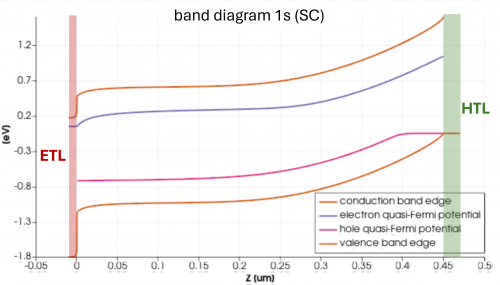single-junction perovskite cell

Feb 15, 2025 Andreas Fell
This example simulates a single-junction perovskite solar cell using the 1D detailed cloupled ionic-electronic drift-diffusion solver
The cell properties are calibrated to the top-cell properties of the tandem cell simulated in Sentaurus device as published in:
Messmer et al., "Toward more reliable measurement procedures of perovskite-silicon tandem solar cells: The role of transient device effects and measurement conditions", PiP 2024, https://doi.org/10.1002/pip.3782
Support by Christoph Messmer (Fraunhofer ISE) is acknowledged in helping to calibrate the device properties to match the Sentaurus Device simulations.
The example contains 3 settingsfiles:
1. PVK_Messmer_transient
Here the hysteresis caused by ion movement during a IV testing is simulated. It shows how to use the transient solutiontype to define a scan of the applied voltage. You can plot the result reverse and forward IV curve by selecting "Vterm" as X and "Jterm" as Y values within the "Curves" results group. This settingsfile also shows how to use "Snapshots", which saves spatial results at define time stamps. In this case at approx. short.circuit conditions a Snapshopt is defined, so you can plot e.g. the band-diagram or ion concentrations at short-circuit conditions during the IV scan.



2. PVK_Messmer_pre-bias
This settingsfile shows how to use the "ion pre-bias" functionality to define a preconditiong of the ions, and then perform a steady-state IV curve simulation which represent a IV scan speed sufficiently fast so that the ions can be considered immobile (ion-freeze).
3. PVK_Messmer_trPL
This settingsfile simulates a transient-photoluminescence decay after sudden turn-off of illumination (e.g. a laser pulse illumination). The n&k values for the perovskite abosber are taken from the KAUST tandem example. n&k are required to model the generation profile from the laser illumination, as well as to model luminescence emission and reabsorption.